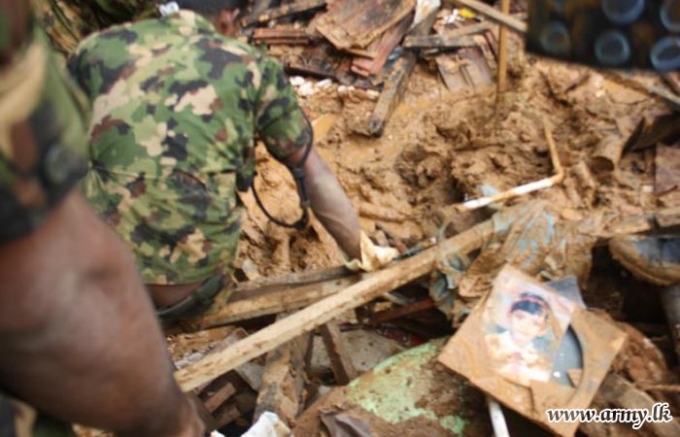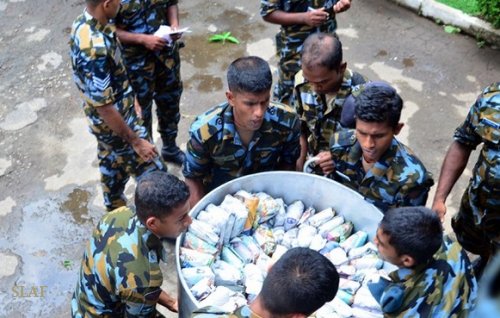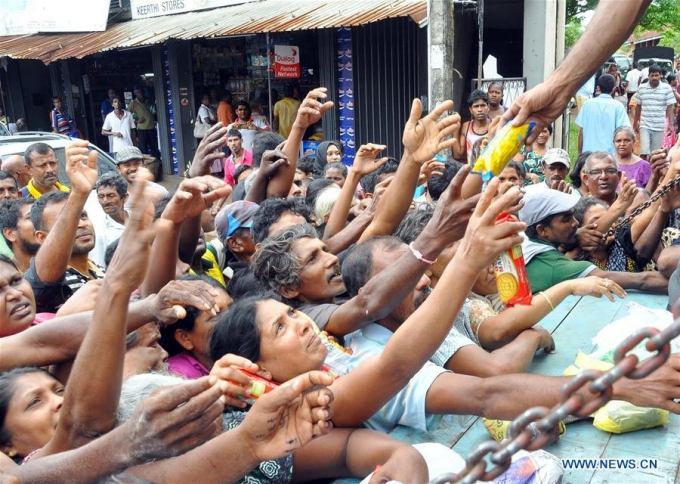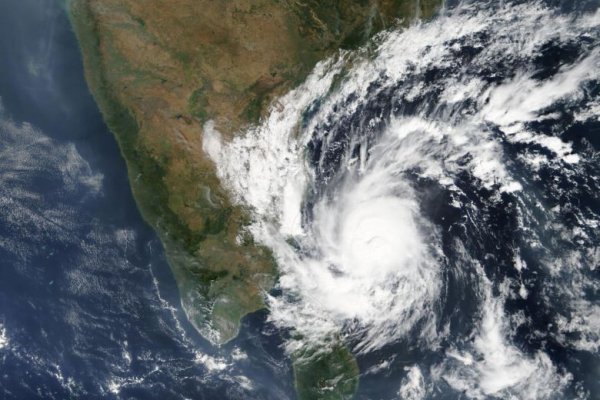
The Southwest monsoon, that typically falls between May and September, is approaching, and we are reminded of the devastation caused by excessive rains in May 2016 and 2017 that led to the loss of lives and displaced thousands of people, as floods and landslides wreaked havoc in parts of the country.
In 2016, a low pressure area over the Bay of Bengal—a precursor to cyclonic storm Roanu—resulted in heavy rainfall exceeding 100 mm in several areas. The rains lasted for four days (May 15, 16, 17, 18) and caused over 100 deaths and displaced close to half a million people.
In Aranayake and Bulathkohupitiya, villages were buried in mud as the area experienced the worst ever landslide in history. In fact, as bodies were pulled out from the rubble, Disaster Management Minister Anura Priyadarshana Yapa pronounced it the “worst disaster situation experienced in the past 24 years”.
Yet, exactly a year later, in just two days (18, 19) of rain in May 2017, a precursor to Cyclone Mora brought floods and landslides that affected 15 districts, claimed the lives of over 200 people and rendered close to 700, 000 people temporarily homeless.
Despite having undergone a disaster of an epic scale just the year before, the Disaster Management Ministry as good as admitted it was unprepared for such a calamity. Copies of a document titled ‘National Disaster Relief Services Centre Requests for Relief’, prepared to be circulated among international donor agencies, indicated the ministry was not in possession of the most basic humanitarian needs such as blankets, life jackets, mobile toilets, umbrellas, torches and matches.
It was the general public that sprang to action, donating their own lunch and organising the collection and distribution of relief items to armed forces personnel on the ground. Disaster Management Ministry Secretary S. S Miyanwala conceded the ministry did not have an adequate stock at its disposal at the time of the flood, citing inability to store some items past their expiry date, and explaining that certain items not available in the market had to be outsourced.

Entire villages were buried in landslides that occured in Aranayake and Bulathkohupitiya. Image courtesy army.lk
In the aftermath of the calamity, fingers were pointed at the government, with pundits proposing the need to improve humanitarian response to disasters through empowering local communities. They also pointed out the need for the use of GPS and drones for locating victims, a request to telecom operators to man a specialised cross network channel for ease of communication, and stockpiling food and essential items.
During the Budget 2018, over Rs. 5.8 billion was allocated to the Ministry of Disaster Management to mitigate damage caused by natural disasters, and with just weeks to go before the onset of the Southwest monsoon, Roar Media thought it fit to find out how much the Ministry, and the institutions affiliated with it, were preparing for the impending rains and the possibility of floods of the scale and nature experienced the two preceding years.
While repeated efforts to solicit an answer from S. Amalanathan, Disaster Management Ministry Additional Secretary (Planning), proved unfruitful, with the Secretary evading response to the questions posed to him, several of the other government institutions were forthcoming with information on the work done in preparation for the expected Southwest monsoon.
Early Warning
Athula Karunanayake, Assistant Director at the Meteorological Department, said the department was preparing its ‘Monsoon Forum’, where stakeholders, that is to say, representatives from the Disaster Management Ministry (including the Disaster Management Minister Ranjith Siyambalapitiya), the Disaster Management Centre (DMC), the National Building Research Organization (NBRO) the National Disaster Relief Services Centre (NDRSC), and the Irrigation Department would be briefed on what weather to expect during the Southwest monsoon.
At the conclusion of the Forum, information relating to the expected weather conditions would be updated on their website and on their Facebook page, Karunanayake said, assuring Roar Media that despite reports that disaster authorities had failed to issue early storm warnings last year, an effective communications system was currently in place.
The Meteorological Department is also currently in the process of creating a mobile app to disseminate weather forecast, Director Sarath Premalal told Roar Media. While he admitted the department did not have an SMS alert system (possibly the best way to disseminate information to users across the island, as mobile penetration grew from 96% in 2012 to 126% in 2017), he said the proposed app would “inform users of expected weather conditions over the next ten days”.
A cursory look at the Meteorological Department’s Twitter page also revealed the tool is heavily underutilized, its last post of consequence on April 17, 2017, right in the thick of the storm. The fact that the Met. Department has made no moves to initiate an SMS alert system—despite the suggestion being made in the aftermath of the 2017 floods, also does not bode well.

Army soldiers were extensively involved in rescue operations during the floods of May 2016 and 2017. Image courtesy cnn.com
Community-Based Warning
The National Building Research Organisation, which, among other things, is tasked with landslide research and risk reduction, said in the year since the floods of 2017, much action had been taken to minimise the damage caused by excessive rains.
Director, Dr. Gamini Jayatissa told Roar Media that foremost among these was a community-based system for early warning and evacuation. “We have identified 13 landslide prone districts, including parts of Colombo, parts of Gampaha, parts of Hambantota and major districts like Badulla, Kandy, Nuwara Eliya, Matale, Kegalle, Ratnapura, Kalutara, Galle and Matara,” he said.
“Over 150 Automated Rain Gauges have been installed in these areas, through which we gather real time rainfall data. We have a 24 hour monitoring centre at the NBRO, with scientists working overnight to monitor rainfall in particular areas,” he said, adding that once a threshold limit is reached, or passed, warnings would be issued to the Disaster Management Centre (DMC), through which the message is disseminated to the community.
“The evacuation mechanism lies with the DMC. We monitor the situation and give out early warnings and other technical information, ” he said, adding that the NBRO planned to increase the number of automated rain gauges to 250 this coming year to gather more accurate information of possible landslides.
“In addition to this, we have initiated a community-based evacuation system, where we educate a group of individuals from vulnerable communities on how to measure rainfall using manual rain gauges and how to issue warnings through a siren we have given them, once the water levels reach a designated level,” he said.
“This way the communities themselves are empowered to act in the event of unprecedented rains that increase the risk of landslides in these areas,” he said, adding that 100 community groups had been established in the Badulla, Nuwara Eliya and Kegalle district, with the NBRO planning to roll out more programmes this year.

The Army distributed food and relief items to those affected by the floods. Image courtesy colombopage.com
The NBRO has a fairly active Facebook page, which was used to issue warnings last year but no Twitter handle which could also be used to inform the public of disaster situations. Dr. Jayatissa also admitted that while the NBRO “had plans” to initiate a SMS alert system, it had not been implemented as yet.
“We don’t yet have an SMS alert system to inform the public, but we are trying our best to establish such a system. It’s in the process, we are in the midst of discussions—we know this is important, and we want to do, but it will take time,” he said.
It is the Irrigation Department that is tasked with warning the DMC of impending floods. Mala Alawatugoda, Hydrology Director (Engineer), told Roar Media the department maintained Automatic Weather Stations across the country which monitor rains and rising river water levels 24 hours.
“We have pre-designated alert levels; the first on this scale is not for the public, but an internal alert for our officers to be vigilant,” she said. “Then there are ‘Minor Flood Levels’ and ‘Major Flood Levels’,” she said, adding that the DMC would be informed the minute water levels reached Minor Flood Level.
The Irrigation Department has a fairly active Facebook page, but no Twitter handle which could be used to warn the public of impending floods. Alawatugoda told Roar Media the department had no plans to launch an SMS alert system or app, stating simply that they would only alert the DMC, which would coordinate alerting the public.
Relief
J. A. D. C. Savithri, Assistant Director of the National Disaster Relief Service Centre (NDRSC), said that while evacuation and rescue lay with the DMC, which acted together with the tri-forces, the NDRSC was in the process of preparing a contingency plan for the upcoming Southwest monsoon rains.
The plan promises to support relief management efforts with better coordination among stakeholders, in much the same manner it prepared for the Northeast monsoon late last year. The NDRSC, with the analysis of historical data, calculates the potential impact to pre-identified vulnerable districts, and plans evacuation centres, provides financial allocations to each district, and maintains a warehouse stocked with items for emergency response and relief, she said.
“In addition to this, we have an insurance scheme that covers all individuals in vulnerable areas, so that we can offer compensation for damaged properties,” Savithri said.
However, it was the NDRSC that was found wanting when the disaster of 2017 hit. The document circulated among donor agencies indicated the warehouse maintained by the NDRSC was lacking the most basic humanitarian needs.
Responding to queries relating to this, Savithri said the NDRSC was unprepared for the scale of the disaster faced in 2017. “We have relief items stocked at the warehouse, but over half a million people affected in two days of rain was unprecedented, and we had to reach out to donor agencies to fill the gap,” she said.
However, it is unclear if the NDRSC has taken necessary action to prepare for possible floods this year, by stockpiling more relief items in anticipation of the expected Southwest monsoon. When questioned, the various officials Roar Media spoke to declined to provide a quantitative answer, choosing to avoid responding to the question altogether.
Coordination
While each of these agencies has very specific tasks to perform, overall coordination lies with the Disaster Management Centre (DMC) that is expected to disseminate warnings to the media and the public, and manage rescue and relief efforts.
Deputy Director, Pradeep Kodippili said starting next week, the DMC would begin emergency response committee meetings at the district level, with the support of the disaster management units that have been set up at each district.

The affected clamour for relief and supplies. Image courtesy xinhuanet.com
“We will also begin discussion with emergency response teams—that is the police, armed forces, electricity board employees etc. to discuss how we will respond to the information received from the Met. Department, the Irrigation Department and the NBRO,” he said.
He said the DMC had already provided emergency response items to the military and the police. “This time we have provided more than 125 boats to district levels and more than 150 water bowsers and other response items as well—rope, generators, wire cutters etc.”, he said.
He said the emergency operations centre at the national headquarters of the DMC, manned by 25-30 people from the tri-forces and police, was used to disseminate warnings. “The tri-forces and police have their own communications network, and we also use these networks to broadcast warnings to all parts of the country,” he said.
Kodippili also said that the DMC had conducted drills with vulnerable communities, educating them on where to go, and what routes to take. “People living in vulnerable areas have faced the possibility of floods and landslides their entire lives,” he said. “This is not something new to them, so when the time comes, they need to move.”
Kodippili was especially critical of the people’s desire to remain in their homes, despite warning to leave. “Last year we provided the warnings in time. People got the message asking them to evacuate, but were more concerned about the safety of their goods, and would not leave their homes until it was too late,” he said.
“People have to change, they have to leave when we warn them to, without staying behind and then having to be rescued by the tri-forces and police,” he said.
Gaps
Be that as it may, in the aftermath of the floods last year, Kodippili said the DMC had not received timely information from the Irrigation Department and the National Building Research Organisation.

The Southwest monsoon, which battered Sri Lanka the past two years, is expected in May. Image courtesy Azzam Ameen/Twitter
G. L. S. Senadeera, DMC Director General, had meanwhile said that the reports from the Meteorological Department had not predicted the intensity of the approaching deluge. “The low pressure system just changed so suddenly, there was no time for anyone to communicate, issue warnings or effect evacuations. It was so sudden and quick,” he was quoted as saying.
The media also highlighted the fact that the Doppler radar system belonging to the Met. Department was inoperative. Although an agreement was signed with the Japan International Cooperation Agency (JICA) in June 2017 to establish another Doppler Weather Radar Network, the project will take almost two years to come into effect.
The DMC had also—in 2009—launched an app known by the acronym ‘DEWN’, (which stands for Disaster Early Warning Network), capable of alerting the public of potential disaster. Despite this, the DMC was accused of failing to alert the public in time when the floods hit in 2016 and 2017.
It is clear that in the aftermath of the devastation last year, several of the institutions that come under the purview of the Disaster Management Ministry have adopted new methods to prepare for disasters. Particularly commendable is the community-based evacuation system initiated by the NBRO that works to empower vulnerable communities.
But it is equally clear that many areas remain unaddressed. Particular among them—and prevalent across the board—is a peculiar reluctance to use SMS warning systems to alert the public of impending disaster. Coupled with the fact that the Met. Department still lacks the technology needed to accurately predict weather, and the underutilization of social media tools, we are unsure—despite the appearance of confidence—if the government is truly ready for a disaster, should it strike this May.
Cover: Close to 700, 000 people were affected in the May 2017 floods. Image courtesy leads.lk







